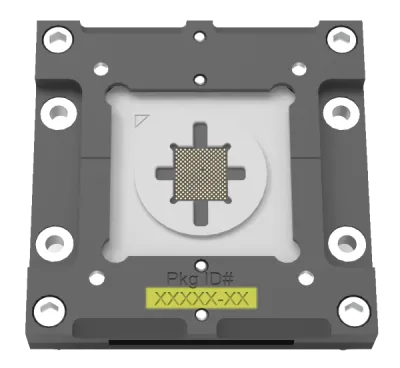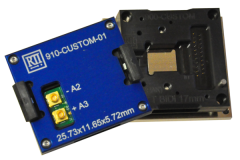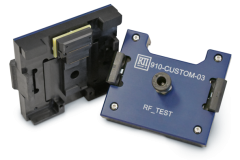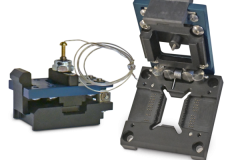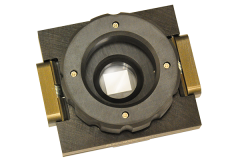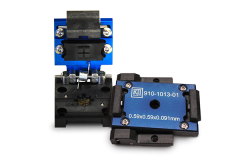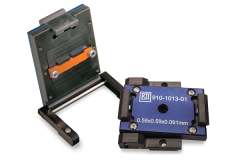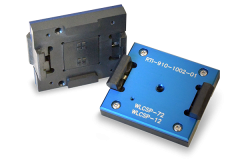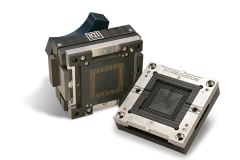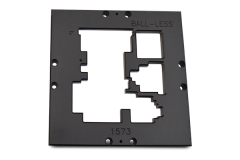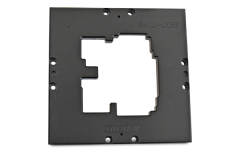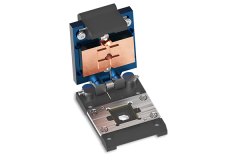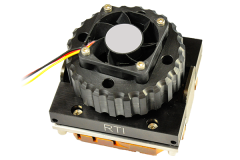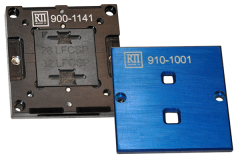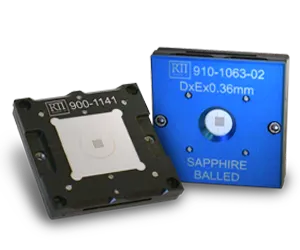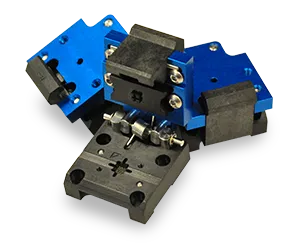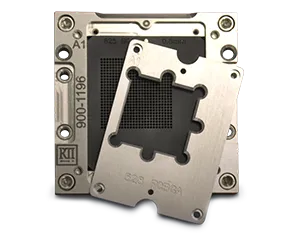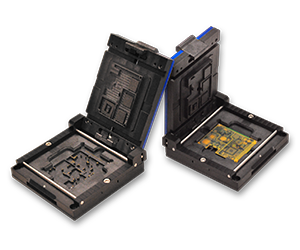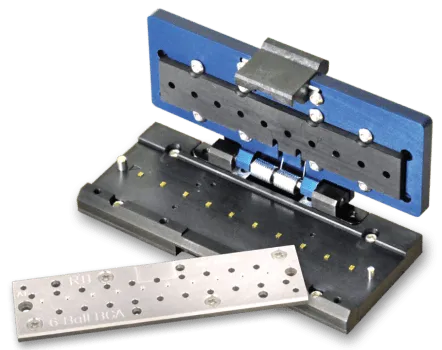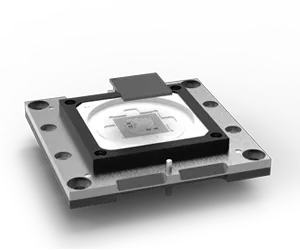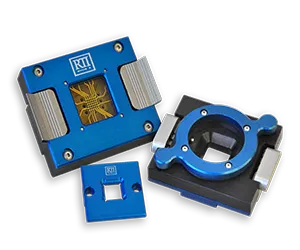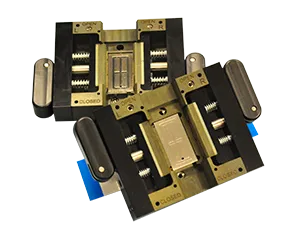Custom Test Socket Lids for Semiconductor & PCB Testing
Open-top, low-profile, and custom-fit lids engineered for test accuracy and repeatability.
RTI's custom test socket lids are designed to align precisely with your device dimensions, socket configuration, and test process. Options include low-profile aluminum lids, spring-loaded pressure plates to control vertical force, or sapphire windows for full DUT visibility during optical inspection, SIL, or EMMI testing. Dual-latch, hinge, and clamp styles support secure engagement and fast changeover in benchtop, FA lab, or production environments. Each lid is machined for even compression, reducing stress on sensitive devices and ensuring consistent electrical contact.
Whether you need a simple open-top lid or a more complex configuration with inspection access, our team will engineer a solution to meet your specific test requirements. Talk with an RTI engineer to get started.
▪ Optimal Compression
Lids apply even vertical compression force to maintain optimal pin travel, apply or avoid witness marks on the DUT, and ensure operational consistency across test cycles.
▪ Integrated Features
For more than just compression force, custom lids can incorporate sensors for thermal management, contacts to test points on the DUT, and incorporate a combination of standard design options.
▪ Dedicated & Universal
Though many lids are designed for specific package footprints, universal lids can be developed for compatibility with a wider range of package footprints and thicknesses.
▪ Quality Materials
From aluminum and stainless steel to Torlon, Ultem, ESD PEEK and more; socket lids prevent warping while observing unorthodox environmental considerations
Custom Test Socket Lids for Semiconductor & PCB Testing
Open-top, low-profile, and custom-fit lids engineered for test accuracy and repeatability.
RTI's custom test socket lids are designed to align precisely with your device dimensions, socket configuration, and test process. Options include low-profile aluminum lids, spring-loaded pressure plates to control vertical force, or sapphire windows for full DUT visibility during optical inspection, SIL, or EMMI testing. Dual-latch, hinge, and clamp styles support secure engagement and fast changeover in benchtop, FA lab, or production environments. Each lid is machined for even compression, reducing stress on sensitive devices and ensuring consistent electrical contact.
Whether you need a simple open-top lid or a more complex configuration with inspection access, our team will engineer a solution to meet your specific test requirements. Talk with an RTI engineer to get started.
▪ Optimal Compression
Lids apply even vertical compression force to maintain optimal pin travel, apply or avoid witness marks on the DUT, and ensure operational consistency across test cycles.
▪ Integrated Features
For more than just compression force, custom lids can incorporate sensors for thermal management, contacts to test points on the DUT, and incorporate a combination of standard design options.
▪ Dedicated & Universal
Though many lids are designed for specific package footprints, universal lids can be developed for compatibility with a wider range of package footprints and thicknesses.
▪ Quality Materials
From aluminum and stainless steel to Torlon, Ultem, ESD PEEK and more; socket lids prevent warping while observing unorthodox environmental considerations
Product Details & More
Here, you'll find helpful links, PDF downloads for manuals and brochures, and related blog posts. For further assistance, please contact our customer support team.
Here, you'll find helpful links, PDF downloads for manuals and brochures, and related blog posts. For further assistance, please contact our customer support team.
Low Profile Screw-Down Socket Lids
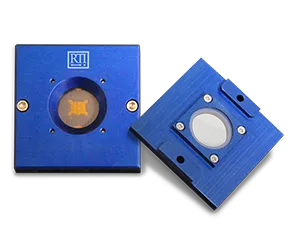
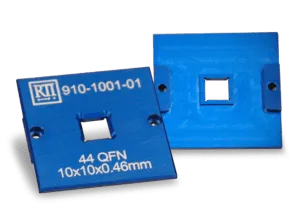
These lids mount to the test socket body with two or four screws. Their low-profile design adds only a few millimeters of thickness to the overall height of the socket making them a great option for optical inspection techniques where an operator needs a close working distance with regards to the surface of the DUT.
Design Options:
- Open Top: Provides physical access to the topside of the DUT. The boundary of the opening is slightly smaller than the DxE dimensions of the DUT in order for the lid to apply compression force while maintaining maximum access to the die.
- Closed Top: Similar to the open top lid design but without cutouts for die access, these lids apply compression force across the entire surface of the DUT.
- Saphire/Quartz Window: Provides optical but no physical access to the exposed die. Typically used with floating base test sockets and WLCSP devices, sapphire windows provide edge-to-edge visibility to the surface of the DUT and optical clarity required for emission microscopy and other optical scanning/inspection techniques.
Clip-On Removable Socket Lids
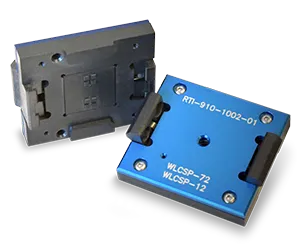
These lids mount to the test socket body with two spring loaded latches and are fully removable from the test socket between tests. Their ease of use and quick-swap capability makes them a great option for low to mid volume manual hand test applications that require rapid exchange of DUTs between test cycles.
Design Features:
- DUT Engagement: Spring loaded pressure plates built into the lid add a layer of compliance for optimal compression force against DUTs with larger thickness tolerances. Pressure plates can be made from various materials to address thermal, magnetic, or other environmental requirements.
- Openings for Airflow: Machined cutouts positioned over the DUT and notches on the spring loaded pressure plate provide improved airflow when used with forced air cooling techniques.
- Ease of Use: Pressing the lid onto the socket automatically locks the latches in place and secures the lid to the socket body. A gentle squeeze on the latches releases the lid.
Adjustable Z-Height Socket Lids
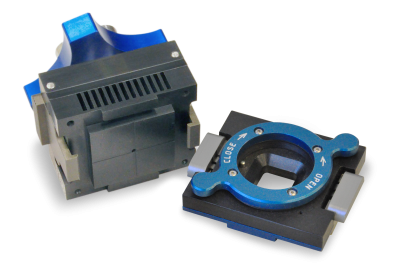
These lids are similar to standard dual-latch clip-on removable lid designs in the way they're secured to the test socket body. However, the z-axis pressure plate is controlled by an adjustable knob rather than embedded springs to offer additional flexibility for test engineers by allowing precise control over the pressure applied to the DUT.
Design Features:
- Adjustable Z-Height: Knobs on the lid provide a hand-tightening mechanism to control the pressure plate that contacts the DUT. The total travel distance of the pressure plate can vary based on user requirements.
- Universal Applications: Some adjustable lids can be used in conjunction with low profile lids, effectively replacing the screw-down compression method with a quick-swap adjustable method. In this configuration, low profile lids are placed on the socket and clip-on adjustable lids are mounted over them before being adjusted to the "closed" position.
- Ease of Use: Fully retract the pressure plate and simply clip the lid to the socket. A large knob and optional extension handle allow the operator to apply substantial compression force on high pin count devices with minimal effort making repeated operation safe and easy.
- Low Profile: With reduced thickness and featuring openings in the knob and pressure plate for improved access to the DUT, forced-air cooling, and other FA applications.
Hinged Clamshell Socket Lids
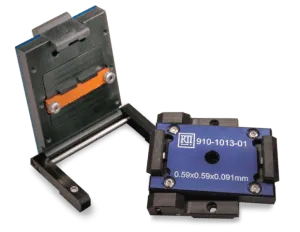
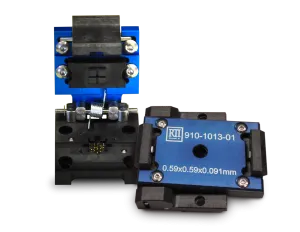
Dedicated single-latch clamshell style lids can be built directly into some test sockets while dual-latch clamshell style lids offer a removable lid alternative for other socket designs. Both lid designs include a spring-loaded pressure plate for evenly distributed compression force against the DUT when closed but make use of different mounting and hinge mechanisms.
Design Features:
- Removable Clamshell: Dual-latch clamshell style lids mount to the socket body with two or four screws for easy removal from the socket so it can be used with other lid styles.
- Fixed vs. Floating Hinge: The hinge pin in single latch clamshell lids is fixed to the socket body whereas the hinge pin on dual-latch removable lids 'floats' in a vertical slot allowing it to travel up and down as the lid is latched and released. This allows the lid to rest flush with the DUT and acts as a vertical guide as compression force is applied.
- Ease of Use: These lids stay attached to the test socket as devices are loaded and unloaded, reducing the chance they are damaged or lost between test cycles. This can also speed up the insertion and removal of DUTs between test cycles.
- Robust Materials: Spring loaded pressure plates in the lid can be made from various materials such as copper, ESD PEEK, and more to address thermal, magnetic, or other environmental requirements.
High Force Latching Socket Lids
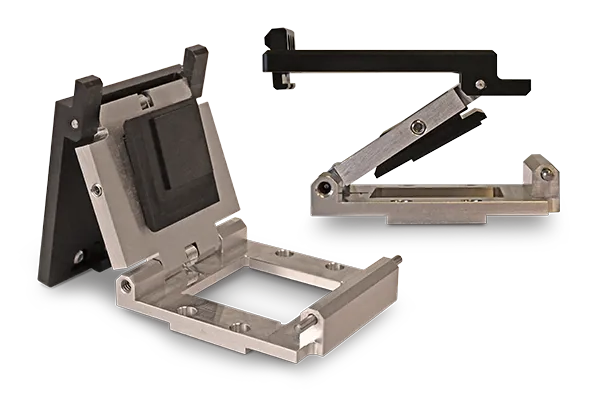
These lids mount directly to the test socket base with four screws making them easily removable. They include a secondary hinged top plate and additional crossbar built into the lid to act as a fulcrum for additional leverage as the lid is fully latched closed. The added mechanical advantage makes these lids easier to operate when testing high force, high pin count, and high density DUTs.
Design Options:
- Gimbal Pressure Plate: A single axis rocking pressure plate rests evenly on the surface of the DUT as the first stage of the lid is closed. This rocking plate reduces sheer force against the DUT as compression force is applied.
- Open or Closed Top: Maintain physical and optical access to the top surface of the DUT through machined cutouts in the lid and gimbal pressure plate.
- Interchangeable Components: The stainless steel frame of the lid can be made for general purposes while the interchangeable rocking gimbal pressure plates can be swapped out to address a variety of package footprints and device thicknesses.
Built-In Interposer Socket Lids
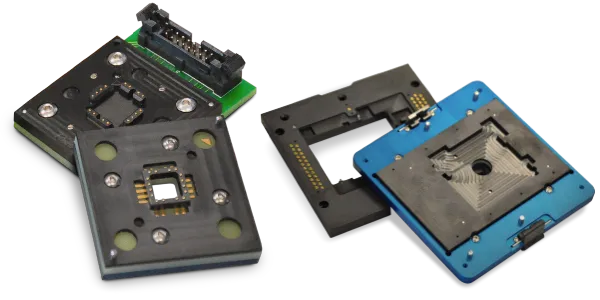
These lids integrate a small printed circuit board (PCB) and spring pins to contact test points on the top side of the DUT and route out signals to connectors in the lid or back down to test points on the DUT board. View the information sheet to see different signal routing configurations that are optimized for various test conditions.
Design Options:
- Mounting Styles: Each lid is customized to match the socket they mate with. They are typically used in screw-down or clip-on removable mounting configurations but can be mounted in other configurations depending on how signals are passed from the lid to the socket and DUT board.
- Open or Closed Top: Maintain physical and optical access to the top surface of the DUT through machined cutouts in the lid and integrated PCB
- Integrated Contacts: Tight tolerance alignment features ensure very fine pitch IC spring probes accurately contact narrow test points on the top surface of your DUT.
Fully Custom Socket Lids
Fully custom lids are designed to customer specification and used with custom test socket bodies. Some of the customization options shown here can be incorporated into standard lid designs. Contact an RTI design engineer to discuss which customization options below are available for your particular needs
Integrated Heatsinks & Fans:
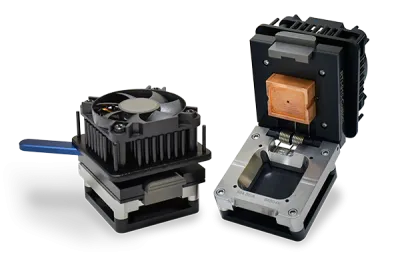
- Copper or nickel-plated aluminum blocks contact the surface of the DUT for added heat dissipation – essential for high wattage devices tested under load.
- These blocks can also be spring loaded for additional compliance and to make sure the block sits flat against the device under test.
- Screw-down, clip-on, clamshell, and z-height adjustable designs available
- Muffin-fans mounted to heat spreaders improve airflow across the heatsink
Contact RTI for additional heatsink-with-heatpipe options.
Rocking Gimbal Pressure Plates:
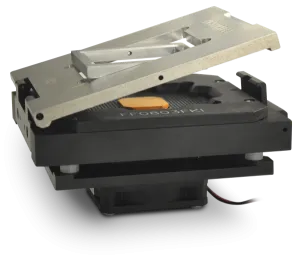
- Machined to match DUT package size for balanced compression at the perimeter of decapsulated packages or entire surface of lidded packages
- Used with single and dual hinge clamshell lids to ensure even and vertical compression as lid is closed, reducing pinching and sheer force against the DUT
- Optional Openings in the rocking pressure plate for topside access and additional airflow across DUTs with large footprints
- Low-profile stainless steel construction for added rigidity. Dedicated and universal design options available
Custom Relief Cutouts:
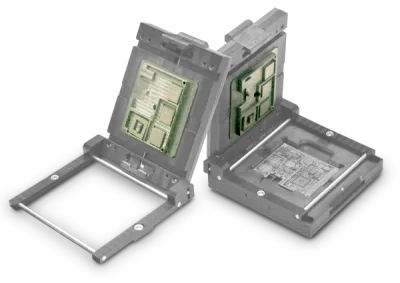
- Apply compression force to specific areas on the DUT
- Clearance for fragile SMT components installed on the DUT, typically found on PCB modules and MCM devices
- Applied to spring loaded pressure plates for clip-on lids or milled directly into aluminum/steel screw-down lids
- Customized to your DUT and operational requirements
On-socket latching:
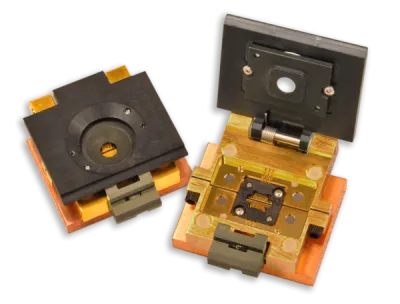
- Latch mechanism doesn't extend beyond the top surface of the lid
- Ideal for low profile lids or where there is limited working area above the socket
- Ease of use: Push-down latch to release spring loaded lid into open position
- Available for custom test socket designs only – contact us for details
Clothespin Release:
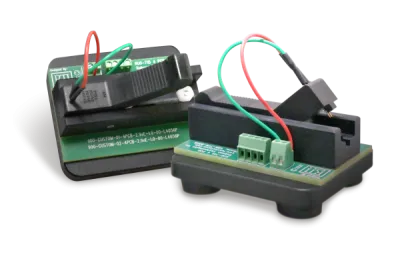
- Rests in the 'closed' clamped position, similar to a clothes pin
- Ease of use: manually align DUT and press to release with minimal effort
- Ideal for probing edge connector contacts on rigid or rigid-flex based DUTs
- Pins installed in the socket base and hinged lid with varying compression force
Integrated Antennas & Connectors:
- Contact test points on top of DUT and route to Coaxial connectors installed on interposer boards embedded in the lid, ideal for RF Test
- Custom spring probes and shielded cable antennas mounted directly to pressure plates in lids contact TX/RX test points on top of DUT
Download Info Sheets Here
Already Have an RTI Socket?
Request a copy of your RTI socket drawing by submitting the form below. You must submit a drawing number or engraved socket number. Your Email domain must be associated with your company for consideration. If requesting drawings on behalf of another company, please provide contact information of someone within the socket-holder's company who can verify your affiliation and drawing request.
Request a copy of your RTI socket drawing by submitting the form below. You must submit a drawing number or engraved socket number. Your Email domain must be associated with your company for consideration. If requesting drawings on behalf of another company, please provide contact information of someone within the socket-holder's company who can verify your affiliation and drawing request.
Request Socket Drawing
Drawing Number Example
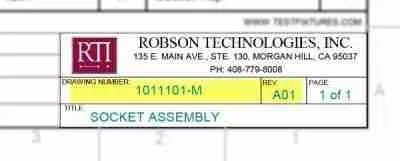
Engraved Socket Number Example
